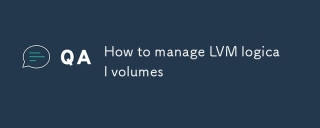 Operation and Maintenance
Operation and Maintenance Linux Operation and Maintenance
Linux Operation and Maintenance How to enable TLS1.2 only in Nginx web server
How to enable TLS1.2 only in Nginx web serverSSL2.0 and SSL3.0 have many known vulnerabilities such as POODLE (CVE-2014-3566), which is why the latest browsers have removed support for these vulnerable protocols. It is recommended that you move your server to use a TLS version, specifically TLS 1.2. This article will introduce how to enable TLS 1.2 using Nginx web server.

Enable TLS1.2 in Nginx only
Edit the Nginx server block section of the domain in the configuration file on the server, And add the following ssl_protocols settings. This will enable only TLSv1.2 protocol in Nginx server block.
ssl_protocols TLSv1.2;
The simplest nginx server block using ssl is as follows
server {
listen 443 ssl;
server_name example.com;
ssl_protocols TLSv1.2;
ssl_certificate /etc/pki/tls/cert.pem;
ssl_certificate_key /etc/pki/tls/private/privkey.pem;Enable TLS 1.1 and 1.2 simultaneously
poodle vulnerability extends from sslv3 to tls 1.0 and 1.1. Therefore, we do not recommend using it for production servers, but if you want to enable it for development. The following configurations can be performed.
ssl_protocols TLSv1.2 TLSv1.1;
After changing the configuration file, restart the nginx service to apply the new settings.
This article has ended here. For more exciting content, you can pay attention to the Linux Video Tutorial Column on the PHP Chinese website! ! !
The above is the detailed content of How to enable TLS1.2 only in Nginx web server. For more information, please follow other related articles on the PHP Chinese website!
 How to manage LVM logical volumesAug 17, 2025 am 08:57 AM
How to manage LVM logical volumesAug 17, 2025 am 08:57 AMLVM management mainly includes extending, reducing, deleting, renaming logical volumes and viewing structures. 1. To expand the logical volume, you need to confirm the remaining space of VG, and then use lvextend to expand and adjust the file system; 2. Before shrinking the logical volume, you must back up, uninstall, check, and shrink the file system and the logical volume in turn; 3. Delete the logical volume first uninstall and then use the lvremove command, rename and use lvrename and update fstab; 4. You can use pvdisplay, vgdisplay, lvdisplay or simplified commands lvs and vgs to view the structure. Be careful when operating to avoid data loss.
 How to install Kubernetes on LinuxAug 17, 2025 am 01:14 AM
How to install Kubernetes on LinuxAug 17, 2025 am 01:14 AMThe steps to install Kubernetes include: 1. Prepare the system environment and dependencies, such as using Ubuntu or CentOS, close swap, install Docker/containerd, kubeadm, kubelet, and kubectl; 2. Use kubeadm to initialize the master node and configure user permissions; 3. Run the kubeadmjoin command on the worker node to join the cluster; 4. Install CNI network plug-ins such as Flannel to ensure the interoperability of Pod networks. The entire process requires attention to details such as firewall, swap settings and network plug-in selection, and problems can be checked through kubelet logs.
 How to use Vagrant for local development environmentsAug 16, 2025 am 03:26 AM
How to use Vagrant for local development environmentsAug 16, 2025 am 03:26 AMSteps to build a local development environment using Vagrant: 1. Install VirtualBox and Vagrant; 2. Execute vagrantinit initialization environment and generate Vagrantfile; 3. Configure virtual machine parameters such as system image, network, and shared folders; 4. Run vagrantup to start the virtual machine and automatically deploy dependencies; 5. Log in to the virtual machine through vagrantssh for service installation and debugging. Common considerations include solving shared folder permission issues, optimizing performance configuration, and rationally managing Vagrantfiles for multiple projects.
 How to monitor system updatesAug 16, 2025 am 02:58 AM
How to monitor system updatesAug 16, 2025 am 02:58 AMThe key to system update monitoring is to establish a mechanism to promptly understand updates. First, use the system's own tools to check and update regularly, such as Linux's apt/yum/dnf, Windows Update and macOS's softwareupdate commands; second, configure the automatic notification mechanism, and implement daily reminders by writing scripts combined with cron timing tasks and email or message push services; finally, for multi-device management scenarios, third-party tools such as Lynis, SaltStack, Ansible, Nagios or Zabbix can be used to centrally monitor and alarm to ensure that system security patches are updated in a timely manner.
 How to troubleshoot THP issuesAug 16, 2025 am 12:51 AM
How to troubleshoot THP issuesAug 16, 2025 am 12:51 AMTHP problem troubleshooting needs to be carried out in accordance with the steps. 1. Confirm whether THP is enabled. Check the /sys/kernel/mm/transparent_hugepage/enabled status. If it is always or madvise, it is recommended to set it to never for delay-sensitive applications; 2. Check whether there is delay caused by THP or the CPU is too high, observe the activity of kcompactd0 or khugepaged process, and monitor the growth of related indicators through /proc/vmstat; 3. Analyze the relationship between the application layer performance and THP. For example, applications such as Redis, PostgreSQL and other applications may cause fork delay or performance degradation due to THP. You can turn it off.
 How to configure AppArmorAug 16, 2025 am 12:16 AM
How to configure AppArmorAug 16, 2025 am 12:16 AMTo enable and check the AppArmor status, execute systemctlstatusapparm. If it is not started, use sudosystemctlstartapparmor and set the power-on and then execute aa-status to view the policy loading status. To create a configuration file, you need to manually store it in the /etc/apparmor.d/ directory or use aa-genprof to generate the basic configuration and then load it through apparmor_parser. During debugging, you can check logs in combination with dmesg or journalctl to find permission problems. You can temporarily switch the complain mode to adjust the policy and then restore the enforce mode. Notes include avoiding direct copying
 How to troubleshoot high load averageAug 15, 2025 am 01:50 AM
How to troubleshoot high load averageAug 15, 2025 am 01:50 AMTo troubleshoot high load average, you must first confirm the load status and then analyze the resource bottlenecks. First, use uptime or top to view the loadaverage value. If it continues to be higher than the number of CPU cores, the system may be under pressure; then run htop, free-h, df-h and iostat-x1 to check the CPU usage, memory, disk space and IO conditions respectively; further use vmstat1 or sar to observe the overall trend, and locate the specific process behavior through pidstat-pPID; judge it as CPU-intensive, IO-intensive, insufficient memory or abnormal processes based on the load type; take measures such as limiting resources, optimizing code, upgrading hardware or releasing caches for different situations; at the same time, you can use
 How to use SSH keys for authenticationAug 15, 2025 am 01:36 AM
How to use SSH keys for authenticationAug 15, 2025 am 01:36 AMUsing an SSH key is more secure and convenient than a password because it has high encryption strength, prevents brute force cracking, and enables password-free login through configuration. 1. The SSH key pair consists of a private key and a public key. The private key is protected with a password, and cannot be used directly even if it is leaked; 2. Use the ssh-keygen-trsa-b4096 command to generate the key, and save the default path, and it is recommended to create independent keys for different purposes; 3. Add the public key to the server to use the ssh-copy-iduser@hostname command or manually copy and paste it in the ~/.ssh/authorized_keys file. Note that the directory permission is set to 700 and the file permission is 600; 4. When using multiple keys, you can use the ~/.ssh/conf


Hot AI Tools

Undress AI Tool
Undress images for free

Undresser.AI Undress
AI-powered app for creating realistic nude photos

AI Clothes Remover
Online AI tool for removing clothes from photos.

Clothoff.io
AI clothes remover

Video Face Swap
Swap faces in any video effortlessly with our completely free AI face swap tool!

Hot Article

Hot Tools

MantisBT
Mantis is an easy-to-deploy web-based defect tracking tool designed to aid in product defect tracking. It requires PHP, MySQL and a web server. Check out our demo and hosting services.

Dreamweaver CS6
Visual web development tools

SecLists
SecLists is the ultimate security tester's companion. It is a collection of various types of lists that are frequently used during security assessments, all in one place. SecLists helps make security testing more efficient and productive by conveniently providing all the lists a security tester might need. List types include usernames, passwords, URLs, fuzzing payloads, sensitive data patterns, web shells, and more. The tester can simply pull this repository onto a new test machine and he will have access to every type of list he needs.

SAP NetWeaver Server Adapter for Eclipse
Integrate Eclipse with SAP NetWeaver application server.

Atom editor mac version download
The most popular open source editor





